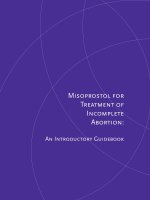Misoprostol for treatment of incomplete abortion
Bạn đang xem bản rút gọn của tài liệu. Xem và tải ngay bản đầy đủ của tài liệu tại đây (174.14 KB, 52 trang )
Misoprostol for
Treatment of
Incomplete
Abortion:
An Introductory Guidebook
MISOPROSTOL FOR
TREATMENT OF INCOMPLETE
ABORTION:
AN INTRODUCTORY GUIDEBOOK
CONTRIBUTORS:
JENNIFER BLUM, JILLIAN BYNUM, RASHA DABASH, AYISHA DIOP, JILL DUROCHER,
ILANA DZUBA, MELANIE PEÑA, SHEILA RAGHAVAN, BEVERLY WINIKOFF
EDITORS:
SHEILA RAGHAVAN AND JILLIAN BYNUM
_______________________________________________
ACKNOWLEDGEMENTS:
WE ARE GRATEFUL TO THE WILLIAM AND FLORA HEWLETT FOUNDATION, DAVID AND
LUCILE PACKARD FOUNDATION AND SWEDISH INTERNATIONAL DEVELOPMENT
COOPERATION AGENCY, WHOSE FUNDING HAS SUPPORTED OUR WORK ON
MISOPROSTOL FOR TREATMENT OF INCOMPLETE ABORTION AND HAS MADE THE
DEVELOPMENT OF THIS GUIDEBOOK POSSIBLE.
Entire content Copyright © 2009 Gynuity Health Projects. This material may not be reproduced
without written permission from the authors. For permission to reproduce this document, please
contact Gynuity Health Projects at
Gynuity Health Projects
15 East 26th Street, 8th Floor
New York, NY 10010 U.S.A.
tel: 1.212.448.1230
fax: 1.212.448.1260
website: www.gynuity.org
information:
Table of Contents
I. Introduction .........................................................................................................1
II. Overview of misoprostol for incomplete abortion .............................................3
What misoprostol is and how it works
•
Formulation
•
Efficacy in treating incomplete abortion
•
Safety
•
Acceptability
•
Comparison to other treatment methods
•
Misoprostol is an important new treatment for incomplete abortion
•
III. Treatment of incomplete abortion using misoprostol ......................................8
Who can receive misoprostol for treatment of incomplete abortion?
•
Who can provide misoprostol for treatment of incomplete abortion?
•
Dose and timing
•
Route of administration
•
Safety of misoprostol for treatment of incomplete abortion
•
IV. Service design, visit schedule and managing complications ............................14
Ultrasonography
•
Provider experience
•
Schedule of clinic visits
•
Managing side effects and complications
•
Follow-up
•
V. Counseling, information provision and service delivery ...................................20
Choosing a method
•
Establishing eligibility
•
Preparing women for what to expect
•
Family planning and contraceptive services
•
Reproductive and other health services
•
Provider and staff training
•
Community and service provider partnerships
•
Desirable (but not required) facilities and supplies
•
VI. Integrating misoprostol into existing postabortion care services .................... 29
VII. Missed abortion .................................................................................................. 30
VIII. Looking forward .................................................................................................. 32
IX. Appendix ............................................................................................................. 34
Frequently Asked Questions
•
X. References ........................................................................................................... 38
1
I. Introduction
The launch of this guidebook follows closely the inclusion of misoprostol for
the management of incomplete abortion and miscarriage in the World Health
Organization’s Model List of Essential Medicines in April, 2009.
1
The Expert
Committee on the Selection and Use of Essential Medicines decided that
misoprostol is as effective as surgery and perhaps safer and cheaper in some
settings. This new status marks a turning point in the role of misoprostol from
a promising technology to an established, internationally recognized essential
medicine for the treatment of incomplete abortion.
Approximately one in five recognized pregnancies are spontaneously miscarried in
the first trimester
2
and an additional 22% end in induced abortion.
3
An incomplete
abortion can result from either spontaneous or induced pregnancy loss and occurs
when products of conception are not completely expelled from the uterus.
Incomplete abortion is closely related to unsafe abortion in many parts of the world.
Where abortion services are restricted, women may seek pregnancy terminations
from unskilled providers, have procedures performed in environments lacking
minimal medical standards, or both.
4
Some women may resort to self-induction.
These conditions increase the likelihood that women will experience abortion
complications and will seek treatment for incomplete terminations.
5
Safe and
effective treatment for incomplete abortion is an important way to reduce
abortion-related morbidity and mortality, particularly in settings where legal
abortion is restricted.
Incomplete abortion can be treated with expectant management, which allows
for spontaneous evacuation of the uterus, or active management, using surgical
or medical methods. Expectant management is not preferred by many providers
due to its relatively low efficacy and the fact that the time interval to spontaneous
expulsion is unpredictable.
6
The standard of care for active management varies by
setting but has traditionally been surgery with general or local anesthesia. Surgical
methods are highly effective for treatment of incomplete abortion. However, these
treatments require trained providers, special equipment, sterile conditions and
often anesthesia, all of which are limited in many settings.
6
2
Medical methods for treatment of incomplete abortion require few resources and
can be administered by low- and mid-level providers.
7
Such technologies could
increase access to services for women far from surgical care facilities. Misoprostol
is the most common and thoroughly studied form of medical management and
offers a highly effective alternative treatment for women wishing to avoid invasive
surgery and anesthesia.
8
In environments with few resources and limited access to
surgical methods, such as primary and secondary care centers, misoprostol allows
for the vast majority of cases to be treated without needing referral to higher level
facilities.
8
Additionally, misoprostol is widely available, easy to administer, stable
at room temperature, accessible, and inexpensive in most countries. Misoprostol
offers women and providers a safe, effective, and non-invasive treatment option
for incomplete abortion that is particularly useful where supplies are limited and
skilled providers are few. In settings where special postabortion care (PAC) services
have been introduced to address morbidity and mortality associated with unsafe
abortion, misoprostol can be integrated easily within existing services.
Information about this Guidebook
This guidebook was created for providers and policymakers who are interested
in learning about misoprostol to treat incomplete abortion, whether arising from
spontaneous or induced pregnancy loss. The goal of this guidebook is to synthesize
the available literature to provide appropriate, effective and safe clinical guidelines
for use of misoprostol in treatment of incomplete abortion. Chapter II focuses on
the efficacy, safety, and acceptability of misoprostol for treatment of incomplete
abortion, while Chapters III through V outline who can be offered the method,
recommended regimens, schedule of clinic visits, management of side effects,
counseling, and service delivery. Chapter VI addresses how misoprostol can be
integrated into existing PAC services and Chapter VII provides brief information on
missed abortion.
3
II. Overview of misoprostol for incomplete abortion
A. What misoprostol is and how it works
Misoprostol (with a variety of trade names, the most common being Cytotec
®
) is
registered in over 80 countries, mostly for prevention of gastric ulcers secondary
to long-term use of non-steroidal anti-inflammatory drugs (NSAIDs). Misoprostol
is a prostaglandin E1 analog which, like natural prostaglandins, affects more than
one type of tissue, including the stomach lining and the smooth muscle of the
uterus and cervix.
6, 9, 10
Over the last two decades, research on use of misoprostol
in reproductive health has burgeoned due to its very effective uterotonic and
cervical ripening properties.
6, 10
At present, misoprostol is an accepted and widely
used treatment for cervical ripening, induction of abortion in the first and second
trimester, prevention and treatment of postpartum hemorrhage, and incomplete
abortion. At the same time, few misoprostol products have been registered for
reproductive health uses.
B. Formulation
Misoprostol is most commonly manufactured as a 200 mcg tablet intended for
oral administration, although 100 mcg pills also exist in some countries.
10
Vaginal
formulations are also available in some places, mostly as a 25 mcg suppository,
but also in larger doses. Misoprostol has several important advantages over other
agents with uterotonic properties. For example, it is stable at ambient temperature
11
while other products require refrigeration or freezing. Some other products are only
administered by injection.
9
Misoprostol is less expensive and more widely available
than other treatments.
11
With new misoprostol products and generics appearing
each year, its price can be expected to decrease as availability increases.
C. Efficacy in treating incomplete abortion
Misoprostol is effective in emptying the uterus because of its ability to induce
uterine contractions and to soften the cervix. Misoprostol for treatment of
incomplete abortion has been well documented in women presenting with uterine
size less than or equal to a pregnancy at 12 weeks since last menstrual period
(LMP).
12
Successful use of misoprostol implies complete evacuation of the uterus
without recourse to surgical intervention. Infrequently, surgical completion may be
needed for retained products of conception, heavy bleeding, or at the request of the
woman. The efficacy rates found in the literature are inconsistent due to differences
in regimens, time to determination of success, and inclusion and exclusion criteria.
However, recent studies have attempted to standardize these variables and have
achieved high efficacy. Overall, in studies that each enrolled more than 100 women
and used misoprostol in at least one treatment arm (600 mcg oral or 400 mcg
sublingual misoprostol) with at least 7 days before follow-up, efficacy averaged 95%
(see Table 1), with success rates as high as 99%.
13
4
Table 1: Misoprostol and Manual Vacuum Aspiration (MVA)
for treatment of incomplete abortion
Year Author N Treatment Time to
Success
Success
2009
Diop A, et al.
14
150;
150
600 mcg oral misoprostol;
400 mcg sublingual
misoprostol
Days 7 & 14 94.6%;
94.5%
2007
Bique C, et al.
15
123 600 mcg oral misoprostol;
MVA
Days 7 & 14 91%;
100%
2007
Dao B, et al.
16
227 600 mcg oral misoprostol;
MVA
Days 7 & 14 94.5%;
99.1%
2007
Shwekerela B, et al.
13
150 600 oral misoprostol;
MVA
Days 7 & 14 99%;
100%
2005
Ngoc NTN, et al.
17
150;
150
600 oral single or
double dose*
Day 7 95.3%;
93.8%
2005
Weeks A, et al.
18
160 600 mcg oral misoprostol;
MVA
Days 7 to 14 96.3%;
91.5%
* 150 women received an additional 600 mcg oral misoprostol dose at 4 hrs (Ngoc NTN, et al.)
5
D. Safety
Misoprostol has been used by millions of men and women worldwide since its
approval in 1988 for prevention of gastric ulcers associated with chronic NSAID
use. Importantly, misoprostol has been used safely for incomplete abortion in many
countries. Misoprostol has not been associated with long-term effects on women’s
health, and prolonged or serious side effects are virtually nonexistent.
E. Acceptability
Women and providers find misoprostol for treatment of incomplete abortion to be
highly acceptable. Many women report that they would choose misoprostol again if
they were to need treatment for incomplete abortion in the future. Research in low-
resource settings in several countries has indicated that over 90% of women were
“very satisfied” or “satisfied” with misoprostol treatment.
13, 16, 17, 18
F. Comparison to other treatment methods
Incomplete abortion can be treated with expectant, surgical, or medical management.
Expectant management involves allowing the uterus to evacuate the products
of conception spontaneously without provider intervention. Generally, expectant
management results in lower success rates compared to active (surgical or
medical) management.
19
Surgical evacuation procedures include dilatation and
curettage (D&C), electric vacuum aspiration (EVA), and manual vacuum aspiration
(MVA). These methods achieve a high success rate (91.5-100%) but carry a small
risk of serious complications including infection, cervical laceration and uterine
perforation. Most important, in many settings, surgical management may not be
feasible. Misoprostol provides an effective, safe, and acceptable treatment option
for women who do not have access to surgical treatment or who wish to avoid
invasive procedures. Rates of gynecological infection after expectant, surgical, and
medical management of incomplete abortion are low (2-3%) and do not differ
by method of treatment.
20
Additionally, experience has shown that women find
misoprostol to be as acceptable as MVA; in fact, in some studies, more women
have reported being “very satisfied” with misoprostol treatment than MVA
treatment.
13, 16, 18
Refer to Table 2 for a comparison of methods of management of
incomplete abortion.
G. Misoprostol is an important new treatment for incomplete
abortion
In countries where legal abortion is restricted, the PAC model provides a framework
for care of women experiencing complications from unsafe abortion (see page 7).
Treatment of incomplete abortion is an essential component of PAC services, and
misoprostol can serve as an effective treatment option. Misoprostol treatment
can be readily integrated into existing PAC services with basic provider training.
Importantly, misoprostol is a safe and effective treatment option for PAC where there
are no other treatment options or where there are few skilled providers.
6
Table 2: Comparing expectant, medical and surgical management
of incomplete abortion
Who can offer the
treatment?
What is needed to
offer the treatment?
What are the risks?
Expectant Mid-level and
skilled providers
Ability to diagnose the
problem
Failure; need for
medical or surgical
completion
Medical Mid-level and
skilled providers
Above plus drug
supplies
Failure; need for
surgical completion;
side effects
Surgical Skilled providers All of the above plus
sterilized equipment,
surgical supplies, and
a special room
Cervical laceration;
uterine perforation;
infrequent failure
7
Essential elements of postabortion care where abortion services
are restricted
21
1. Community and service provider partnerships
• Preventunwantedpregnanciesandunsafeabortion
• Mobilizeresourcestohelpwomenreceiveappropriateand
timely care for complications from abortion
• Ensurethathealthservicesreectandmeetcommunity
expectations and needs
2. Counseling
• Identifyandrespondtowomen’semotionalandphysicalhealth
needs and other concerns
3. Treatment
• Treatincompleteandunsafeabortionandpotentiallylife-
threatening complications
4. Contraceptive and family planning services
• Helpwomenpreventanunwantedpregnancyorpracticebirth
spacing
5. Reproductive and other health services
• Preferablyprovidedon-site,orviareferralstootheraccessible
facilities in providers’ networks
8
III. Treatment of incomplete abortion using
misoprostol
A. Who can receive misoprostol for treatment of incomplete
abortion?
Eligibility criteria
Misoprostol can be used for early, uncomplicated incomplete abortion.
Eligible women have the following:
Open cervical os
Vaginal bleeding or history of vaginal bleeding during this pregnancy
Uterine size of less than or equal to 12 weeks’ LMP
Women who are NOT eligible have the following:
Known allergy to misoprostol or other prostaglandin
Suspected ectopic pregnancy
Signs of pelvic infection and/or sepsis
Hemodynamic instability or shock
Assessment of uterine size
Providers should assess a woman’s uterine size prior to misoprostol
administration. A woman with a uterus 12 weeks’ LMP or smaller is
eligible for treatment with misoprostol. Uterine size can be estimated by
conducting a physical exam. Precise dating of the initial gestational age
is unnecessary as long as the uterine size at presentation for treatment is
equivalent to a pregnancy of 12 weeks’ LMP or less.
Precautions to use of misoprostol for treatment of incomplete abortion:
Intrauterine device (IUD) in place: Women who have an IUD in place
should have the IUD removed before misoprostol administration.
Information to women who are breastfeeding: Misoprostol is quickly
metabolized in the body,
22,23
however, small amounts of misoprostol or
its metabolite may appear in breast milk. No adverse effects in nursing
infants have been reported, and there are no known consequences
of such exposure.
24
If there is any concern, women can be advised to
discard the breast milk produced for the first few hours after misoprostol
administration.
Uterine size larger than 12 weeks’ LMP: Misoprostol may be used with
caution in women with a uterine size larger than 12 weeks’ LMP
(e.g. uterine enlargement due to fibroids).
B. Who can provide misoprostol for treatment of incomplete
abortion?
Misoprostol can be provided by mid-level and skilled providers practicing in
primary, secondary and tertiary care facilities. The most important skill is to know
who could benefit from the treatment. Providers who are offering other reproductive
health services may already have the skills needed to offer misoprostol as a
treatment option for incomplete abortion.
9
Myth: Misoprostol is not an appropriate treatment for women in
rural areas
Misoprostol may be the most appropriate treatment choice for rural
women because care can be provided by mid-level providers in the absence
of surgical equipment and ultrasound. If a treatment facility is unable to
provide surgical completion in the event of method failure, a referral clinic
can provide this care.
C. Dose and timing
High efficacy rates with acceptable side effect profiles have been obtained with
both a single 600 mcg oral dose
13, 14, 15, 16, 18
and with a single 400 mcg sublingual
dose of misoprostol.
14
Recent research has shown that these two regimens work
equally well.
14
Repeated dosing within a short interval does not seem to improve
efficacy.
25
The recommended dosing regimen is a single administration of either
600 mcg oral or 400 mcg sublingual misoprostol (see Table 3). The lower dose
may be advantageous in settings where cost of misoprostol is a concern. Success
of misoprostol for treatment of incomplete abortion in the first trimester is
independent of gestational age at the time of miscarriage/abortion.
26
10
Table 3: Recommended regimens of misoprostol for treatment of
incomplete abortion
12, 27
Dose Misoprostol Route of Administration
600 mcg oral
400 mcg sublingual
Myth: Only physicians can administer misoprostol for treatment
of incomplete abortion
Given the nature of misoprostol treatment (oral medication), trained
non-physician health workers can be effective treatment providers,
increasing the number of providers. In some areas, nurses, midwives and
other non-physician trained providers are already using misoprostol for
treatment of incomplete abortion.
11
Madagascar: Adapting the 400 mcg sublingual misoprostol
regimen for PAC into national reproductive health norms
and protocols
A large maternity hospital in Madagascar recently completed a study
comparing a 400 mcg sublingual dose to a 600 mcg oral dose of
misoprostol for treatment of incomplete abortion.
14
Shortly after the
launch of the study, it became clear to providers that treatment with
the misoprostol regimen yielded high efficacy rates in addition to
increased access and improved services. Over-burdened doctors saw
their workload decrease as in-patient PAC patients were screened
and treated by nurse midwives. Patient follow-up was also managed
by these mid-level service providers. Given the lower cost of a 400
mcg versus 600 mcg dose and the similarity in efficacy, the Ministry
of Health added a 400 mcg sublingual misoprostol regimen for the
treatment of incomplete abortion to the Reproductive Health Norms
and Protocols.
Future plans in Madagascar include expanding the use of misoprostol
for incomplete abortion to lower levels of the healthcare system. The
focus will be on providing training and developing curricula for lower
level providers. Misoprostol’s potential may best be realized as a first-
line treatment in community-level health facilities when used by lower
level health providers such as nurses and midwives.
12
D. Route of administration
Misoprostol for incomplete abortion has been administered vaginally, orally, and
sublingually.
14, 28, 29, 30
A number of studies have demonstrated very high efficacy
(greater than 90%) and acceptability using the oral route.
13, 14, 15, 16, 18
The oral
route is effective, simple, and acceptable to both women and providers. Recent
experience has shown that lower dose sublingual administration is as effective as
oral administration.
14
If misoprostol is taken sublingually, the woman holds the
pills under her tongue for about 30 minutes. Any remaining pill fragments can be
swallowed with water.
E. Safety of misoprostol for treatment of incomplete abortion
Misoprostol has been studied for treatment of incomplete abortion in many
settings. It has been used safely by thousands of women seeking postabortion care
with almost no side effects. Misoprostol has not been associated with long-term
effects on women’s health.
Frequently cited safety concerns include:
Excessive bleeding: Excessive bleeding warranting transfusion is rare;
31
misoprostol for treatment of incomplete abortion is no more likely to
result in transfusion than other treatments.
19
Anemia: Misoprostol treatment is not associated with increased risk
of anemia. A recently completed study shows no clinically significant
difference in change in hemoglobin between women treated with
misoprostol or MVA for incomplete abortion. Very few women had
clinically significant drops in hemoglobin (0.3% misoprostol, 0.9% MVA).
32
Infection: Risk of infection is low. The rate of infection in women who
receive misoprostol for treatment of incomplete abortion is similar to the
rate in women who receive other treatments.
19, 20
There is no evidence that
misoprostol increases the risk of infection.
13
Ectopic pregnancy: Misoprostol will not cause, complicate, or treat an
ectopic pregnancy. Suspected ectopic pregnancy is a contraindication
to use of the method.
12
However, it is possible to confuse symptoms
of ectopic pregnancy (e.g. pelvic pain and bleeding) with those of
spontaneous pregnancy loss. Careful evaluation before treatment and
good clinical judgment are essential to identify women with suspected
ectopic pregnancies so that they may be referred for appropriate diagnosis
and treatment.
Use in women with history of cesarean section: There is no clinical reason
to withhold misoprostol from women with previous cesarean sections. Such
women have not been excluded in studies of misoprostol for treatment of
incomplete abortion; misoprostol used for incomplete abortion according
to the guidelines above is generally safe in this population.
Teratogenic effects: Women seeking PAC services do not have viable
pregnancies; therefore concerns about the potential teratogenic effects of
misoprostol are not relevant for this indication.
IV. Service design, visit schedule and managing
complications
A. Ultrasonography
Ultrasound machinery is not essential to provide misoprostol for treatment of
incomplete abortion. Misoprostol can be offered in PAC facilities and at levels
of care that lack ultrasound equipment or where ultrasound is too costly. An
incomplete abortion can be diagnosed by clinical history and examination;
complete evacuation can be assessed using the same set of clinical techniques.
33
Several recent studies in low-resource settings rarely used ultrasound to diagnose
incomplete abortion (<5% of diagnoses were confirmed via ultrasound) or to
confirm uterine evacuation.
13, 14, 15, 18
Ultrasound can be used if the provider has expertise in the technique: the biggest
danger is in over-interpretation of normal amounts of debris in the uterus, leading
to unnecessary surgical completion. Providers should be aware that women treated
successfully with misoprostol have been found to have a wide range of endometrial
thicknesses on ultrasound at follow-up; therefore it is recommended that the
decision to perform surgical evacuation be based on clinical signs rather than
ultrasound findings.
34
Unnecessary intervention to evacuate the uterus may occur
when providers see debris on ultrasound but misinterpret its clinical significance.
35
14
Myth: Ultrasound is necessary prior to and after misoprostol for
treatment of incomplete abortion
Many providers are concerned about offering misoprostol where ultrasound
may not be available. However, ultrasound is not necessary to use
misoprostol for treatment of incomplete abortion. Clinical history and
examination are sufficient for diagnosis of incomplete abortion; complete
evacuation can be assessed in the same way. Experience has shown the safety
and efficacy of misoprostol in the absence of routine ultrasound.
13, 14, 15, 18
Providers can refer women to facilities with ultrasound if they are uncertain
of the woman’s status following misoprostol treatment.
B. Provider experience
The effectiveness of misoprostol as a treatment option for postabortion care
services is in part dependent on provider familiarity with and confidence in the
regimen. Clinical assessment of when and if surgical intervention is medically
necessary is subjective and dependent on experience with the method. Providers
who are confident and familiar with the regimen are more likely to make clinical
judgments that avoid surgical intervention.
36
An inexperienced provider may feel
uncomfortable allowing misoprostol to take its course or may misjudge the status
of completion and decide to intervene surgically. Accordingly, as providers become
comfortable with misoprostol for treatment of incomplete abortion, success rates
will generally rise.
25
C. Schedule of clinic visits
A woman who chooses misoprostol for treatment of her incomplete abortion
usually has one initial visit and could be encouraged to make a follow-up visit.
During the initial visit the diagnosis of incomplete abortion is made, the woman is
counseled, she is provided information about what to expect with treatment, and
misoprostol is administered. Depending on the healthcare system and provider
and patient preference, the woman can take misoprostol either at the clinic or
at home. There is no medical reason to observe women in the clinic following
misoprostol administration.
15
Providers should also be sure to allow sufficient time for misoprostol to work, as
time to complete the process can vary from one day to several weeks.
37
To avoid
unnecessary surgical intervention, the follow-up visit to assess health status
should be scheduled no less than 7 days after misoprostol administration. This
visit schedule is associated with consistently high success rates, but the method
does fail for approximately 1 out of every 20 women. Unless medically necessary
for hemostatic or infection control, surgical intervention prior to 7 days is not
recommended. Women should be advised that medical help can be sought at any
point during treatment if needed.
16
Myth: Women should be observed at the clinic following
administration of misoprostol or until the abortion is complete
There is no medical reason to observe women in the hospital or the clinic
following administration of misoprostol. Women can be sent home with
the misoprostol to administer later or immediately after taking it at the
clinic. They should be informed of potential side effects, how to handle
them, and when to seek additional care. Several recent experiences in low
resource areas have followed these guidelines and achieved high efficacy
with low rates of complications.
13, 15, 16, 18
D. Managing side effects and complications
Side effects associated with misoprostol treatment of incomplete abortion are
well-studied and generally easy to manage. Each woman should be informed about
potential side effects and how to handle them. Women should also be instructed to
seek additional care (either at the clinic or at an emergency facility) in the event of
very heavy and/or prolonged bleeding or persistent fever. Table 4 lists common side
effects and management strategies.
17
Myth: Misoprostol is not as safe as surgical methods; misoprostol
has a higher rate of heavy bleeding compared to surgical methods
Women should be informed of what to expect following treatment with
misoprostol, and when to seek care for heavy bleeding. Excessive bleeding
requiring transfusion is no more likely to result from misoprostol for
treatment of incomplete abortion than from surgical management. Some
research shows that more women report heavy bleeding with medical
management compared to surgical management,
15,16,18
while other research
finds similar bleeding patterns following treatment with either misoprostol
or surgical methods.
32,38
Table 4: Common side effects of misoprostol and their management
when used for treatment of incomplete abortion
Description Management
Pain/
cramping
Cramping typically starts within the first few hours
and can begin as early as 30 minutes following
misoprostol administration. Pain may be stronger
than that typically experienced during a menstrual
period.
> Sitting or lying comfortably
> Hot water bottle or heating pad
> Paracetamol/acetaminophen
> Non-steroidal anti-inflammatory drugs (NSAIDs)
such as ibuprofen
Chills/
fever
Chills are a transient but common side effect
of misoprostol. Fever is less common and does
not necessarily indicate infection. Temperature
elevation generally does not last more than a few
hours. Though infection is rare, fever or chills
that persist for longer than 24 hours may indicate
infection.
> Reassurance that chills and fever are common side
effects of misoprostol
> Antipyretics if needed
> Women should be instructed to contact a medical
provider if fever or chills persist for more than
24 hours or develop more than one day after
taking misoprostol
Bleeding
Generally, vaginal bleeding will commence within
an hour of misoprostol administration. Bleeding
typically lasts an average of 5 to 8 days (but may
continue up to 2 weeks). Spotting can persist until
the next menstrual period.
> Give women information on expected bleeding
> Women should be instructed to notify a health care
provider if they experience the following:
•Soakingmorethan2extralargesanitary
pads (or local equivalent) per hour for
more than 2 consecutive hours
•Suddenheavybleedingafterbleedinghas
slowed or stopped for several days
•Continuousbleedingforseveralweeks
with dizziness or light-headedness
Heavy
bleeding
Heavy and/or prolonged bleeding that causes a
significant change in hemoglobin is uncommon.
A few women will present with heavy bleeding
according to the guidelines above.
> Surgical completion if bleeding is profuse
or prolonged
> Administration of intravenous fluids if there is evidence
of hemodynamic compromise
> Transfusion should be provided only when clearly
medically indicated
Nausea/
vomiting
Nausea and vomiting may occur and typically
resolve within 2 to 6 hours.
12
> Reassure women that nausea and vomiting are
possible side effects
> An antiemetic may be used if necessary
Diarrhea
Diarrhea is a common, transient side effect of
misoprostol that should resolve within a day.
> Reassure women that diarrhea is sometimes
associated with misoprostol use and passes quickly
Infection
Documented endometrial and/or pelvic infection
is rare. Infection is typically treated with oral
antibiotics.
> If infection is suspected the woman should be
evaluated
> If there are signs of sepsis or severe infection women
should be given immediate surgical evacuation and
antibiotic coverage
> Severe infections could require hospitalization and
parenteral antibiotics
18
19
E. Follow-up
If routine follow-up is scheduled by the providers, it should be planned for no
less than 7 days after misoprostol treatment. Very few follow-up visits prove to
be medically necessary for the woman. Women should be educated about the
symptoms of retained tissue and infection so they will know when a follow-up visit
is medically necessary.
Women who return for follow-up should be asked to report side effects and bleeding
patterns. Bimanual exam will help the provider assess whether the uterus is firm,
involuted, and pre-pregnancy size. Experience in low-resource settings has shown
that patient history and clinical exam are sufficient to assess whether the process is
complete.
13, 14, 15, 18
If a woman is thought to have retained products of conception but
is not experiencing any signs of infection or severe bleeding, she should be offered
the choice between an additional follow-up visit in approximately one week and an
immediate surgical evacuation (either by D&C or suction aspiration). Women may
also be offered an additional dose of misoprostol at the follow-up visit, as this may
offer some benefit.








